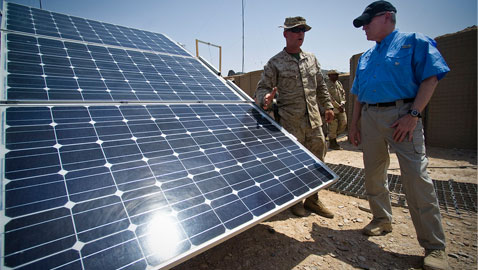
The Ministry of New and Renewable Energy will implement a scheme for setting up 300-MW grid-connected and off-grid solar photovoltaic power projects by defence establishments as well as paramilitary forces with Viability Gap Funding support of Rs.750 crore under the second and third phases of Jawaharlal Nehru National Solar Mission during the period 2014-15 to 2018-19.
The objectives of the scheme are to achieve energy security by utilising the available land and rooftops of the defence sector and paramilitary forces for installation of solar power plants, and at the same time, encourage the use of domestically manufactured equipment to boost indigenous production of solar cells and modules.
For implementation of the scheme, the Government of India has already permitted the use of defence land by developers chosen by defence establishments for setting up solar power projects. Such land can also be used by the defence establishments themselves for installation of solar power plants. The excess power generated by the solar power plants may be sold to distribution companies.
The scheme covers establishments of the Army, Navy, Air Force, Ordinance Factory Board, defence laboratories and defence public sector undertakings as well as paramilitary forces that fall under the Ministry of Home Affairs. These establishments may identify locations anywhere in the country including in border areas for developing solar power projects under the scheme during the five-year period starting from 2014-15.
Even if some of the locations identified fall along international borders but do not belong to either the Ministry of Defence or the paramilitary forces, such land can still be used for developing solar power projects under the scheme provided the defence forces, defence-related organisations or paramilitary forces are able to partly or fully use the power generated by the solar power plants.
The minimum project capacity allowed under the scheme is 1 MW and the maximum up to 20 MW.
The tendering process for developing the solar power projects will be done by the defence establishments themselves, if necessary, in phases, based on availability of land and rooftops. The MoD is free to follow its own procurement systems, or alternatively, develop detailed guidelines and procedures for carrying out the tendering process.
The defence establishments and paramilitary forces can either adopt the developer mode or the EPC mode for setting up the grid-connected solar PV power projects of 300 MW aggregate capacity.
In case of developer mode, the MNRE will provide VGF with a view to make solar power available at a predetermined fixed tariff of Rs.5.50 per unit for the project period of 25 years. In case of accelerated depreciation benefit, the tariff has been reduced to Rs.4.75 per unit. The power purchase agreement will be signed between the selected developer and the defence establishment where land is located. The surplus power generated can be sold to distribution companies by the developer or the defence establishment may buy the entire power and sell the surplus to distribution companies at its end. The VGF will be provided to developers based on their bid. The developers will be selected on the basis of bids for minimum VGF requirement with commitment to supply solar power at the pre-determined tariff. Taking into consideration technological upgradation and economies of scale, the MNRE has categorized the upper limits of VGF in three groups. The limits are Rs.2.5 crore per MW for project capacity up to 5 MW in category I, Rs.2 crore per MW for project capacity greater than 5 MW and up to 25 MW in category II, and Rs.1.5 crore per MW for project capacity greater than 25 MW in category III.
The category in which a particular project falls will be determined based on its alternating current capacity and on the basis of contiguity of the geographical location. The developer needs to put his own equity of minimum Rs.1.5 crore per MW. The VGF will be released in six tranches.
In the EPC mode, the defence establishment will own the project and get it developed through an EPC contractor. The VGF is admissible if the contract gets awarded through open tender based on total price or cost of setting up and commissioning of the project. The VGF will be released in four installments based on actual progress of work. The last installment of 25 per cent of VGF will be released only after successful commissioning of the project.
Keeping in view technological upgradation and economies of scale, the VGF has been set at a fixed rate of 30 per cent of the price of the project excluding price of land and operation and maintenance charges, or Rs.2.5 crore per MW, whichever is lower, for capacity up to 5 MW, Rs.2 crore per MW for capacity greater than 5 MW and up to 25 MW, and Rs.1.5 crore per MW for capacity greater than 25 MW.
Where the accelerated depreciation benefit is availed, the VGF will be limited to Rs.1.5 crore per MW for capacity up to 5 MW, Rs.1 crore per MW for capacity greater than 5 MW and up to 25 MW, and Rs.0.50 crore per MW for capacity greater than 25 MW. There is no need to fix tariff and sign PPA in case of the projects developed in the EPC mode.
The solar power projects developed under the MNRE scheme have to use solar cells and modules made in India.
Off-grid solar applications are also covered under the scheme.











